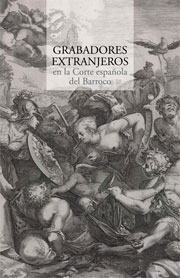Author
Javier Blas, María Cruz de Carlos and José Manuel Matilla
Characteristics
746 pages; 980 color illustrations; hardcover with jacket; 24,5 x 30 cm
Publication
Spanish; jointly published with the Biblioteca Nacional de España; 2011
ISBN
978-84-15245-19-3
Price
€115,20
The shortage of engravers in sixteenth-century Spain prompted the arrival of a large group of foreign artists (mostly from France, Flanders and England), who contributed to the development of printed images that served the interests of the Spanish monarchy, breathing new life into engraving practices and languages between the reigns of Philip II and Philip IV.
This volume records and analyses the output of these engravers in Madrid, documenting their stays in the city, their commissions, and the production and meaning of the images executed in their workshops. This information is compiled into an exhaustive study of their works featuring more than a thousand catalogue raisonné entries with illustrations, which will be a key reference work for scholars of the arts and printing in Habsburg Spain.
Javier Blas is a corresponding member of the Real Academia de Bellas Artes de San Fernando, where he currently holds the post of coordinator of projects and institutional relations. He was previously director of the Calcografía Nacional (2000–6), head of Collections at the Museo Nacional Centro de Arte Reina Sofía (2006–8), and a collaborator with the Department of Drawings and Prints at the Museo del Prado (2009–11). As an expert in graphic art, he has directed the Centro de la Estampa Digital, and has been a member of the technical committee of Estampa and advisor at Ingráfica. He is also scientific editor and a member of the editorial board of the journal Goya.
María Cruz de Carlos Varona is a lecturer at the Department of Art History and Theory of the Universidad Autónoma in Madrid. She worked at the Museo del Prado from 2013 to 2016, both in the Department of Drawings and Prints and at the Prado School. Her lines of research, centred on the Modern Age, encompass the artistic culture of women, religious images, and the history and culture of prints. Her work in these three areas has appeared in many Spanish and international publications and she has also organised several courses and seminars.
José Manuel Matilla is head of the Department of Drawings and Prints at the Museo Nacional del Prado, where he designed the comprehensive program for the acquisition, study, publication, and exhibition of Francisco de Goya’s series of prints, which resulted in the exhibitions devoted to the Disparates (1999), Caprichos (1999–2000), Disasters of War (2001) and Tauromaquia (2002–3). He has curated the exhibitions Alonso Cano. Dibujos (2001), Imágenes del Quijote. Modelos de representación en las ediciones de los siglos XVII a XIX (2003), El Grafoscopio. Un siglo de miradas al Museo del Prado (1819–1920) and De Miguel Ángel a Annibale Carracci. Un siglo de dibujos italianos en el Museo del Prado (both in 2004), and Durero. Obras maestras de la Albertina (2005).

